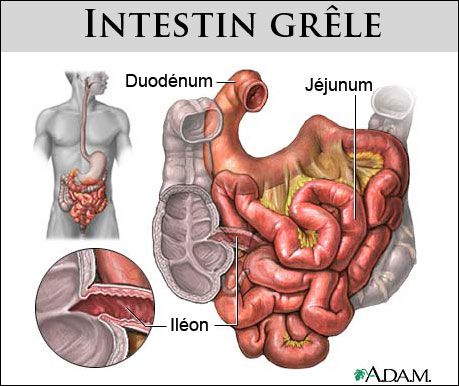-
 Creosote
Creosote
-
 Nyctinasty
Nyctinasty
-
 Confocal laser scanning microscope
Confocal laser scanning microscope
-
 PCM
PCM
-
 Skipjack
Skipjack
-
 Air brake
Air brake
-
 Renewable energy
Renewable energy
-
 Continental slope
Continental slope
-
 Cyberspace
Cyberspace
-
 Tracheostomy
Tracheostomy
-
 Epiphyses
Epiphyses
-
 FTP
FTP
-
 Lambda phage
Lambda phage
-
 AFSSAPS
AFSSAPS
-
 Neptune
Neptune
-
 Optical prism
Optical prism
-
 VOD
VOD
-
 Anabolism
Anabolism
-
 Hydromorphy
Hydromorphy
-
 Metacarpus
Metacarpus
-
 Up quark
Up quark
-
 Gmail
Gmail
-
 Crystalline facies
Crystalline facies
-
 Breadfruit
Breadfruit
-
 Wave power plant
Wave power plant
-
 Biogas
Biogas
-
 STI
STI
-
 Critical temperature
Critical temperature
-
 Nucleation
Nucleation
-
 GFP
GFP
Small intestine
The small intestine is part of the gastrointestinal tract.
Function of the small intestine
The small intestine follows the stomach and is composed of the duodenum, jejunum and ileum. Its function is to continue the digestion of foods, and particularly to absorb nutrients.
The intestine secretes intestinal juice, which is neutral or slightly basic and contains the enzymes required to convert chyme (the food digested by the stomach) into chyle, which only contains nutrients.
Foods are absorbed by these passing from the lumen of theintestine to the inside by la crossing the intestinal wall. Glucose and sugars in general, amino acids, short chain fatty acids and glycerol pass into blood vessels. Long chain fatty acids and triglycerides pass into lymph vessels. Water, minerals and vitamins can pass into either of these vessels.
Structure of the small intestine
The smallintestine is an average of 6 metres in length and increases the contact surface area between nutrients and the wall to by up to 250 square meters. It is the presence of folds at different levels which make this increase possible: co-operating valvules (folds in the mucosa) covered by intestinal villi (folds in intestinal connective tissue) and also cellular micro-villi (folds in the enterocyte plasma membrane).
Peristaltic movement of food occurs as a result of the circular and longitudinal muscle layers.
 The small intestine is composed of the duodenum, jejunum and ilium. © www.health.allrefer.com
The small intestine is composed of the duodenum, jejunum and ilium. © www.health.allrefer.com
Latest
Fill out my online form.



